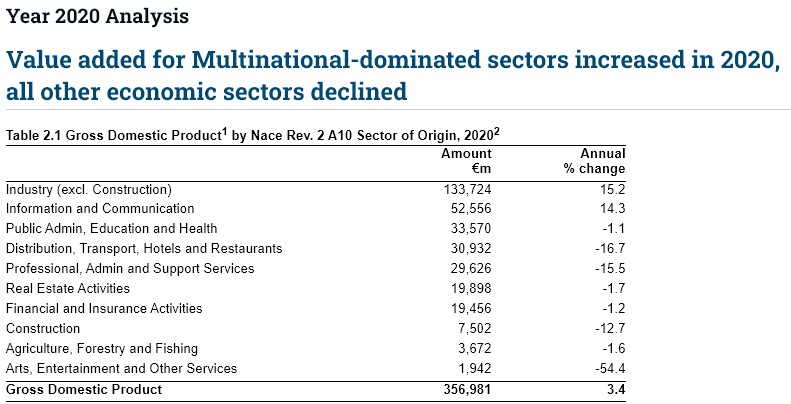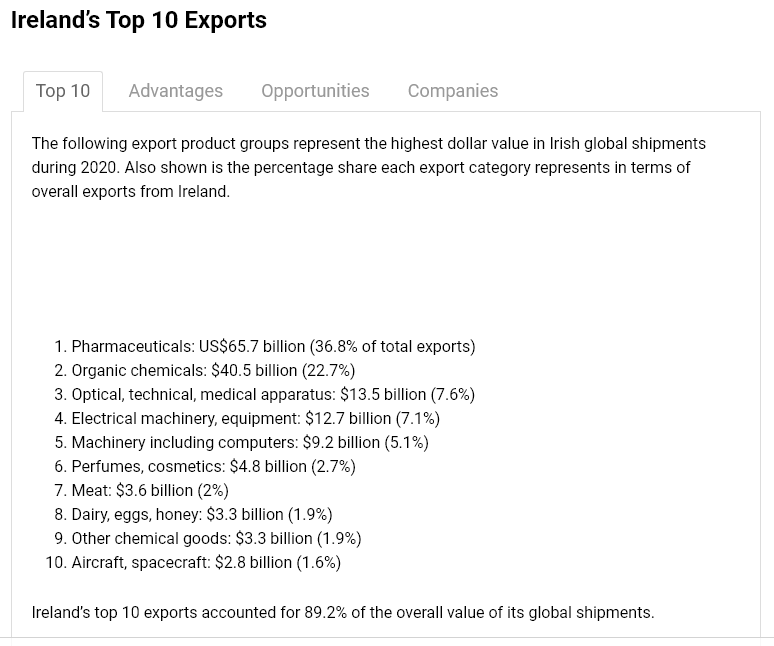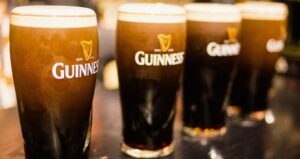If you found this post via search, it probably makes sense to start with the first post in this series. The link to the full series is above.
In this series of posts, I examine seven specific nations that created economic value which transformed them from fairly poor countries to fairly rich countries.
The focus of this post is Ireland sometimes referred to as the Celtic tiger.
Table of Contents
Regarding the image at the top of the post
There may be nothing more Irish than the “two-part pour” of a pint of Guinness.
If you’ve never been and seen it yourself, I’m sure you can find videos on YouTube, but the basic idea is:
- You hold the glass at an angle and fill the glass almost all the way.
- You sit the glass on the bar for maybe two minutes, while the bubbles settle.
- You top it off.
What I never knew is this two-part pour is controversial.
Apparently, someone on BuzzFeed published an article claiming it’s the greatest marketing myth in history, which didn’t sit well with some long-time pint pullers.
Personally, I think it’s cool to watch the bubbles settle, so I like the two-part pour method, whether it’s necessary or not. If it is a marketing ploy, they got me
Background information
While the island of Ireland has been continuously occupied for 10,000 years or so, the history of modern Ireland effectively starts with English annexation and occupation.
In 1541 Henry VIII declared himself to be King of Ireland, which led to English and Scottish settlers showing up, taking land, creating the plantation system, and sowing the seeds for the Catholic/Protestant divide that continues to this day.
A monoculture agricultural system based on a single species of potatoes laid the foundation for the famine when, due to a plant disease named “blight”, the potato crops failed in 1845, 1846, and 1847. From 1845 to 1851 two million people (one-quarter of the population) died or emigrated elsewhere.
The population of Ireland has STILL never reached the prefamine level of 8 million.
Tensions between Ireland and England ebbed and flowed, and early in the 20th-century violence escalated into open warfare, resulting in a treaty that partitioned the island of Ireland into two countries, Northern Ireland which is part of the UK today, and Ireland which is not.
Not that this next bit is super relevant to the economic history of modern Ireland, but I think it’s noteworthy that Ireland remained neutral during WW2, which means they were not bombed by Germany during WW2 nearly to the extent Northern Ireland was (although they were bombed on several occasions).
As a result, Ireland both had less post WW2 rebuilding to do, and (it seems irony often accompanies war) as a result, “missed out on” the economic stimulus of the post WW2 rebuilding.
The economic boom some describe as the economic miracle starting around 1987.
The Government
For a country whose primary language is English, they use Irish language names for the various entities and functions within their government.
The President
The President is the head of state and supreme commander of the Irish Defence Forces.
The president appoints the various government ministers, including the Taoiseach, the Tánaiste, and judges.
The Taoiseach
Taoiseach means Prime Minister. The Taoiseach is the head of the government.
The person holding this position is appointed by the president after being nominated by a simple majority vote by the voting members of the Dáil.
The Tánaiste
The Tánaiste is the deputy head of government, second in command under the Taoiseach. The Tánaiste is appointed by the President on the advice of the Taoiseach.
The Dáil
Dáil means parliament.
The Dáil Éireann
The Dáil Éireann is the lower house of the Irish legislature. Conceptually equivalent to the Canadian House of Commons or the American House of Representatives.
There are 160 seats and members are directly elected for terms not to exceed five years.
The Seanad Éireann
The Seanad Éireann is the upper house of the Irish legislature. Conceptually equivalent to the Canadian or American Senate.
The member senators are not directly elected (as is also true in Canada) but consists of members chosen by various methods.
The Courts
The Irish court system has two branches (Criminal and Civil) each of which consists of five levels: District Court, Circuit Court, Central/High Court, Court of Appeal, and Supreme Court.
There are also two specialty courts: children’s court, and drug treatment court (which I think is a very interesting concept)
Politics
During the period of open warfare in the early part of the 20th century, Ireland had a political party with an army.
Everyone has heard of the IRA, but not everyone knows their beginnings.
In its early days, the Irish Republican Army was affiliated with the Sinn Féin party.
Today, Sinn Féin disavows the IRA. The two organizations are separate and distinct.
Not only is Sinn Féin still a political party in Ireland, but they are also the largest political party in the Dáil today, but just barely.
The Wikipedia page on this topic lists 16 political parties in Ireland, 9 of which have seats in the current Dáil Éireann.
Today, the Sinn Fein party holds 37 seats, which is one more than than the Fianna Fáil party.
Government corruption
Transparency International is an organization that ranks nations on government corruption.
They rank Ireland as the 20th least corrupt government in the world.
For reference, the United States ranks as the 67th least corrupt government, and Canada recently slipped from 8th place to 12th place.
The legal system
While the legal system of Ireland is based on English common law, as is common with most ex-English colonies (including the United States) it blends in historical practices as well as statutes from legislation both pre 1922 and post 1922.
There is no code of criminal procedure per se. Instead, the system is regulated by statute interpreted by case law.
The banking system
Ireland is in the eurozone, and as such does not have a sovereign currency.
Ireland uses the euro, for which the central bank is the European Central Bank.
Effectively, it seems Ireland exchanged control of their currency for the ability to participate in the free trade zone of the European Union.
Having said that, there is a Central Bank of Ireland, and while I watched a number of “about us” videos on their website, all I really understand is there is some sharing of responsibilities between the European Central Bank and the Central Bank of Ireland, but I don’t understand quite where the dividing lines lie.
Healthcare
Ireland has a government-funded healthcare system available to anyone who has lived in Ireland for a year, or declares that they will stay in Ireland for at least one year.
Care is provided by a network of public and private facilities. Most hospitals outside of Dublin are state-owned, while hospitals in Dublin are not.
Side note: The “rumor” that Guinness was once served in hospitals in Ireland was confirmed to me by both my Irish-born grandparents, who, in spite of the stereotype of Irish, shall we say, embellished storytelling, were absolutely credible witnesses. Near as I can tell from searching on the Internet, the origin of that Guinness ad campaign, and that doctors in hospitals prescribed it, had to do with the iron content. Guinness does not in fact have high iron content. One pint contains 3.4% of the daily iron needs of men and 2.0% of the daily needs of women.
Natural resources
Farm land
Quality farmland was an important resource for most of the 20th century, but now agriculture consists of 1.6% of Irelands GDP and employes about 5% of the workforce.
Fishing
Not a huge part of the Irish economy, but as with most maritime nations, fishing has been and is important to Ireland.
Oil and gas
Not a major player in the global oil markets, but Ireland is estimated to have about a billion barrels of oil reserves. Developing natural gas deposits is at odds with protecting the environment.
Direct government support and intervention
As the economic miracle was getting underway, deals were made within Ireland to help Ireland become more competitive in international markets.
Labour unions agreed to accept stagnant wages in exchange for a fairly generous welfare state.
The overall agreement was called The Program for National Recovery, and included tax reforms, increased welfare payments, increased healthcare spending, a minimum wage, spending for social housing, subsidies for some industries producting exports, and more.
Direct foreign investment
As you can see in the graphs below, Ireland became very open to direct foreign investment starting in 1986.
Initially, the idea that direct foreign investment could be negative seemed counterintuitive, so I used Google and learned that direct foreign investment can be lower than zero and what that means is outflows of investment exceeded inflows.
This can indicate some investments were sold, reinvested outside the country (a subsidiary setting up a subsidiary), the company operating at a loss, etc.

Important partnerships
The obvious partnerships are:
Membership in the European Union
Which provides tariff-free access to the third-largest trading block on earth.
The Program for National Recovery
The Program for National Recovery was an agreement between employers, trade unions, farming interests, and the government about what changes to make in law and priorities specifically aimed at growing the economy.
Three subsequent agreements had a broadly similar form.
- The Programme for Economic and Social Progress (1990-1993)
- The Programme for Competitiveness and Work (1994-1996)
- Partnership 2000 (1997-2000)
In that last one, the idea of “constituents” was widened to include people generally not represented in economic development programs, specifically people representing the unemployed. women’s groups, and other groups addressing social exclusion.
GDP by sector
The chart below shows the 2020 GDP by sector. As you can see, in 2020 every sector shrunk except the top two.

Exports by sector
The chart below shows the top 10 exports for 2020, which account for just under 90% of all exports.
I personally had no idea pharmaceuticals are such a strong part of Ireland’s total exports.

Wealth and income equality
The most widely used measure of income distribution is the Gini index. It condenses several data points into a single number from 0 (perfect equality) to 1 (perfect inequality), although it is sometimes expressed as a number between 0 and 100.
Ireland has a 2021 Gini index of 32.8, which ranks it as the 131st most unequal country on earth, which, considering 172 countries are being scored, is a very good score.
For comparison, the Gini index of the United States is 41.1 (54th most unequal) and for Canada is 33.3 (127th most unequal).
Rich? Or paper profits?
We’ve all heard stories of Ireland being a financial “pass-through” country, and corporations moving there to take advantage of low corporate tax rates, and corporate inversions where an Irish subsidiary becomes the headquarters specifically for tax reasons, so I did a few Google searches on this topic and found people questioning whether Ireland is “corporation rich” on paper and whether the wealth stays in Ireland.
And… there is some skepticism about this.
GDP vs GNI
One source of this skepticism is a paper written by Patrick Honohan, a prior governor of the Central Bank of Ireland.
He claims that using GDP as a measure includes transactions that stay within corporations operating in Ireland, and when you analyze the Irish economy through the lens of GNI (modified gross national income) the picture, while still pretty good, is not nearly as good.
In 2019 Ireland had the second-highest GDP in the European Union and the eighth-highest GNI.
GDP vs Per capita disposable income
A comparison of GDP growth vs per capita disposable income growth shows a similar conclusion.
In 2015 Irelands GDP grew by an astounding 24 percent in one year.
Yet this was a “paper fiction” created by the “relocation” of intellectual property assets to Irish subsidiaries and headquarters so that income generated from IP licensing was taxed at Irish corporate rates.
In the same year, Irish per capita disposable income grew by a more reasonable 4.9 percent.
In closing
The one thing Ireland has in common with the four Asian Tigers is that “government intervention” was integral to the economic success of Ireland.
In the case of Ireland, it seems the government was in the driver’s seat for putting together the economic development plan and was the party to get everyone talking and to broker the agreements that seems to be what made the enormous economic success of Ireland happen.
Representatives from various sectors of Irish society participated in putting the plans together, agreed to the plans, and did their parts in executing the plans.



